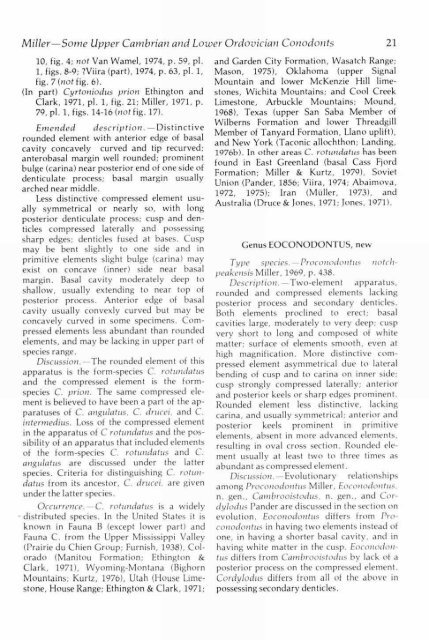View - KU ScholarWorks - University of Kansas
View - KU ScholarWorks - University of Kansas
View - KU ScholarWorks - University of Kansas
You also want an ePaper? Increase the reach of your titles
YUMPU automatically turns print PDFs into web optimized ePapers that Google loves.
-conodon<br />
Miller—Some Upper Cambrian and Lower Ordovician Conodonts 21<br />
10, fig. 4; not Van Wamel, 1974, P. 59, pl.<br />
1, figs. 8-9; ?Viira (part), 1974, p. 63, pl. 1,<br />
fig. 7 (not fig. 6).<br />
(In part) Cyrtoniodus prion Ethington and<br />
Clark, 1971, pl. 1, fig. 21; Miller, 1971, p.<br />
79, pl. 1, figs. 14-16 (not fig. 17).<br />
Emended description. — Distinctive<br />
rounded element with anterior edge <strong>of</strong> basal<br />
cavity concavely curved and tip recurved;<br />
anterobasal margin well rounded; prominent<br />
bulge (caria) near posterior end <strong>of</strong> one side <strong>of</strong><br />
denticulate process; basal margin usually<br />
arched near middle.<br />
Less distinctive compressed element usually<br />
symmetrical or nearly so, with long<br />
posterior denticulate process; cusp and dentides<br />
compressed laterally and possessing<br />
sharp edges; denticles fused at bases. Cusp<br />
may be bent slightly to one side and in<br />
primitive elements slight bulge (caria) may<br />
exist on concave (inner) side near basal<br />
margin. Basal cavity moderately deep to<br />
shallow, usually extending to near top <strong>of</strong><br />
posterior process. Anterior edge <strong>of</strong> basal<br />
cavity usually convexly curved but may be<br />
concavely curved in some specimens. Compressed<br />
elements less abundant than rounded<br />
elements, and may be lacking in upper part <strong>of</strong><br />
species range.<br />
Discussion, —The rounded element <strong>of</strong> this<br />
apparatus is the form-species C. rotwidatus<br />
and the compressed element is the formspecies<br />
C. prion. The same compressed element<br />
is believed to have been a part <strong>of</strong> the apparatuses<br />
<strong>of</strong> C. angulatus, C. drucei, and C.<br />
intertnedius. Loss <strong>of</strong> the compressed element<br />
in the apparatus <strong>of</strong> C rotundatus and the possibility<br />
<strong>of</strong> an apparatus that included elements<br />
<strong>of</strong> the form-species C. rotundatus and C.<br />
angulatus are discussed under the latter<br />
species. Criteria for distinguishing C. rotundatus<br />
from its ancestor, C. drucei, are given<br />
under the latter species.<br />
Occurrence. — C. rotundatus is a widely<br />
- distributed species. In the United States it is<br />
known in Fauna B (except lower part) and<br />
Fauna C. from the Upper Mississippi Valley<br />
(Prairie du Chien Group; Furnish, 1938), Colorado<br />
(Manitou Formation; Ethington Sz<br />
Clark, 1971), Wyoming-Montana (Bighorn<br />
Mountains; Kurtz, 1976), Utah (House Limestone,<br />
House Range; Ethington Sz Clark, 1971;<br />
and Garden City Formation, Wasatch Range;<br />
Mason, 1975), Oklahoma (upper Signal<br />
Mountain and lower McKenzie Hill limestones,<br />
Wichita Mountains; and Cool Creek<br />
Limestone, Arbuckle Mountains; Mound,<br />
1968), Texas (upper San Saba Member <strong>of</strong><br />
Wilberns Formation and lower Threadgill<br />
Member <strong>of</strong> Tanyard Formation, Llano uplift),<br />
and New York (Taconic allochthon; Landing,<br />
1976b). In other areas C. roturidatus has been<br />
found in East Greenland (basal Cass Fjord<br />
Formation; Miller &T Kurtz, 1979), Soviet<br />
Union (Pander, 1856; Viira, 1974; Abaimova,<br />
1972, 1975); Iran (Muller, 1973), and<br />
Australia (Druce & Jones, 1971; Jones, 1971).<br />
Genus EOCONODONTUS, new<br />
Type species. — Proconodontus notchpeakensis<br />
Miller, 1969, p. 438.<br />
Description. — Two -element apparatus,<br />
rounded and compressed elements lacking<br />
posterior process and secondary denticles.<br />
Both elements proclined to erect; basal<br />
cavities large, moderately to very deep; cusp<br />
very short to long and composed <strong>of</strong> white<br />
matter; surface <strong>of</strong> elements smooth, even at<br />
high magnification. More distinctive compressed<br />
element asymmetrical due to lateral<br />
bending <strong>of</strong> cusp and to caria on inner side;<br />
cusp strongly compressed laterally; anterior<br />
and posterior keels or sharp edges prominent.<br />
Rounded element less distinctive, lacking<br />
caria, and usually symmetrical; anterior and<br />
posterior keels prominent in primitive<br />
elements, absent in more advanced elements,<br />
resulting in oval cross section. Rounded element<br />
usually at least two to three times as<br />
abundant as compressed element.<br />
Discussion. — Evolutionary relationships<br />
among Proconodontus Miller, Eocotiodontits,<br />
n. gen., Cambrooistodus, n. gen., and Cordylodus<br />
Pander are discussed in the section on<br />
evolution. Eoconodontus differs from Pro<br />
tus in having two elements instead <strong>of</strong><br />
one, in having a shorter basal cavity, and in<br />
having white matter in the cusp. Eocoriotioutus<br />
differs from Cambrooistodus by lack <strong>of</strong> a<br />
posterior process on the compressed element.<br />
Cordylodus differs from all <strong>of</strong> the above in<br />
possessing secondary denticles.
















